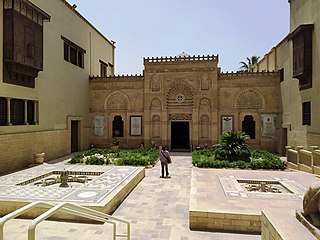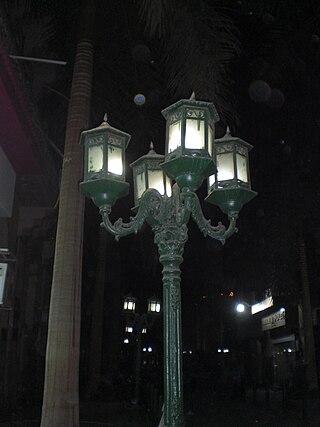
A corniche is a road on the side of a cliff or mountain, with the ground rising on one side and falling away on the other. The word has been absorbed into English from the French term route à corniche or "road on a ledge", itself derived from the Italian cornice, for "ledge".

Egyptian Revival is an architectural style that uses the motifs and imagery of ancient Egypt. It is attributed generally to the public awareness of ancient Egyptian monuments generated by Napoleon's conquest of Egypt and Admiral Nelson's defeat of the French Navy at the Battle of the Nile in 1798. Napoleon took a scientific expedition with him to Egypt. Publication of the expedition's work, the Description de l'Égypte, began in 1809 and was published as a series through 1826. The size and monumentality of the façades discovered during his adventure cemented the hold of Egyptian aesthetics on the Parisian elite. However, works of art and architecture in the Egyptian style had been made or built occasionally on the European continent and the British Isles since the time of the Renaissance.

Hassan Fathy was a noted Egyptian architect who pioneered appropriate technology for building in Egypt, especially by working to reestablish the use of adobe and traditional mud construction as opposed to western building designs, material configurations, and lay-outs. Fathy was recognized with the Aga Khan Chairman's Award for Architecture in 1980. In 2017, Google celebrated Fathy with a Google Doodle for "pioneering new methods [in architecture], respecting tradition [Egyptian heritage and tradition], and valuing all walks of life".
The year 1892 in architecture involved some significant events.

Welton David Becket was an American modern architect who designed many buildings in Los Angeles, California.
The April 2005 attacks were three related incidents that took place in the city of Cairo, Egypt, on 7 April and 30 April 2005. While the first killed three bystanders, the latter two incidents are generally considered to have been minor, in that they caused no loss of life other than those of the perpetrators and appear not to have been planned in advance. Neither sophisticated methods nor sophisticated materials were used in the incidents, and the Egyptian authorities have consistently described the attacks as "primitive".

Ramses Railway Station, also called Misr Station, is the main railway station of Cairo, Egypt. The name is derived from the Ancient Egyptian Pharaoh Ramses II, whose statue was erected by Nasser on the square there in 1955.

Heliopolis was an early 20th Century suburb outside Cairo, Egypt, which has since merged with Cairo and is administratively divided into the districts of Masr al-Gadida and al-Nozha in the Eastern Area.

The Grand Egyptian Museum, also known as the Giza Museum, is an archaeological museum under construction in Giza, Egypt. It will house artifacts of ancient Egypt, including the complete Tutankhamun collection, and is set to be the largest archaeological museum in the world. Many pieces in its collection will be displayed for the first time. The museum is sited on a plot of land of about 480,000 square metres (5,200,000 sq ft) approximately 2 kilometres from the Giza pyramid complex and was built as part of a new master plan for the Giza Plateau called Giza 2030.

Ancient Egyptian architecture is best known for its monumental temples and tombs built in stone, including its famous pyramids, such as the pyramids of Giza. These were built with a distinctive repertoire of elements including pylon gateways, hypostyle halls, obelisks, and hieroglyphic decoration. The advent of Greek Ptolemaic rule, followed by Roman rule, introduced elements of Greco-Roman architecture into Egypt, especially in the capital city of Alexandria. After this came Coptic architecture, including early Christian architecture, which continued to follow ancient classical and Byzantine influences.
Ramses Wissa Wassef (1911–1974) was an Egyptian Coptic architect and professor of art and architecture at the College of Fine Arts in Cairo and founder of the Ramses Wissa Wassef Art Centre.

Coptic architecture is the architecture of the Coptic Christians, who form the majority of Christians in Egypt.
Prof. Dr William Selim Hanna (1896–1980), born in Assiut, Egypt وليم سليم حنا, was an Egyptian Minister of Housing. A prominent structural engineer, Hanna completed his education in Alexandria and Cairo and graduated from the Faculty of Engineering of Cairo University in 1920 with an engineering diploma. He then traveled to England and joined the University of Birmingham, where he earned a bachelor's degree with first place honors in Civil Engineering in 1923. He studied for a doctorate in the same university and received his PhD in 1926.

Qasr el Nil street or as Egyptians say : Asr el Nil street is a street in downtown Cairo, Egypt, one of the biggest streets in Cairo, with many businesses, restaurants, and an active nightlife.
William B. Tabler Sr. was an American architect who designed more than 400 hotels. He was best known for giving Hilton hotels the clean but sometimes stark face of corporate America, most notably in the 46-story slablike New York Hilton Midtown near Rockefeller Center.
Events in the year 2019 in Egypt.
Mahmoud Riad was a prolific Egyptian architect, urban planner, and housing policy maker. Over a four decade career, Riad designed and built many iconic buildings in New York, Cairo, Alexandria and Kuwait, and is considered a "foundational figure in twentieth century Egyptian architecture," and one of the 'pioneer' Egyptian architects. He held government positions in architecture and planning departments, and founded the Egyptian government's first high office for housing, the Department of Popular Homes.










